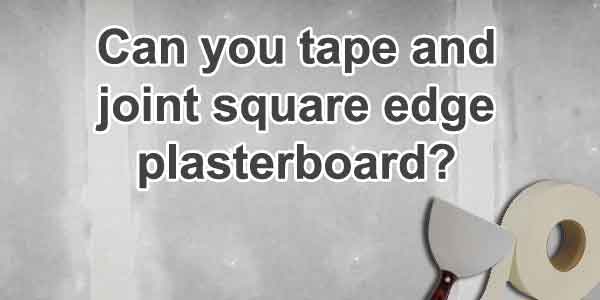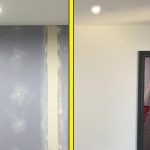As a general rule, you would usually use tapered edge plasterboard if you were planning to tape and joint. It is better to skim square edge plasterboard, as this will create a flat even surface, that hides the joints between each plasterboard.
However, even tapered edge plasterboards are not tapered on all sides. Only the long sides have tapered edges. This means you still get butt joints where the boards meet end-to-end.

In order to fill and hide these butt joints, you will need to tape them and then use a joint filler (such as Easifill). In order to completely hide the joint, the filler needs to be feathered out on either side. This is done, by applying a thin coat and feathering it out gradually over 150-200mm.
When you fill a butt joint, the filler will naturally create a slight bulge. If this is not feathered out correctly, it will be very noticeable when the light hits it.
By feathering the joint with a joint filling compound, you create the illusion of a completely flat surface. This is because the slightly raised filler at the joint, is gradually tapered to nothing. If this is done correctly, it should completely hide the joint.
It is possible to tape and joint square edged plasterboards. This would be done the same way as filling butt joints. The joint would be taped and filled, and the filler would be feathered out to completely hide the joint. If this is done well, it can produce a seamless finish.
But should you tape and joint square edge plasterboard?
As we have already mentioned, it is possible to tape and joint square edge plasterboard. However, just because you can do it, doesn’t mean it is the best option.
If you have a small area to board, plus you already have square edge plasterboards, and you are reasonably skilled, then fair enough. But it definitely shouldn’t be your first choice.
Where possible, you should always try to use tapered edge boards and keep butt joints to a minimum. This is simply due to the fact, that hiding the square butt joints is more difficult.
When using tapered edge boards, it is very easy to fill and completely hide the joints. The same is true for fully skimming square edged plasterboard.
Obviously skimming plaster is a skilled trade, and this may mean you need to hire a plasterer. However, it will guarantee a flat and seamless finish.
Its also worth noting, that feathering joint filler on a butt joint, also requires a reasonable level of skill. If you do a bad job, the joints in the boards will be obvious.
This is particularly true, if you are unskilled and you are filling a large number of long joints (2400mm on a standard plasterboard). If this is the case, it is very likely some of the joint’s won’t be perfect. This will become very obvious once they are painted, and it could result in a really poor-quality finish.
The advantage of tapered edge plasterboard
The advantage of using tapered edge plasterboard is quite clear. It enables you to fill and sand the joints with ease. There is very little skill required. If you can mix something like Easifill and spread it over the joint with a trowel or a filling knife, you should be able to do a good job.
The tapered edge creates an indent where the boards meet, and you simply apply filler flush with the front of the board. Again, this is pretty easy. You just need to drag the blade of your trowel over the joint and the filler should sit flush with the surface.
Because of this, it doesn’t require any feathering to hide the joint. Once the filler is applied, and the tapered edge is sufficiently filled, you can simply give it a light sand for a perfectly flat finish.
Feathering a butt joint is far more difficult, it will require a certain degree of skill to completely hide the joint. This is fine for the occasional butt joint. However, there is a much bigger margin for error if you use this method to finish entire square edged plasterboards.
Conclusion
You certainly can tape and joint a square edge plasterboard. But it is rarely going to be the best option. If you are very skilled and it has to be done, then it is certainly doable. However, where possible, a tapered edge board will always be a better choice if you are drylining.
If you already have square edged boards, and there are many joints that need filling, then skimming the boards is probably your best choice. It is extra expense, but at least you know the finish will be high quality.




